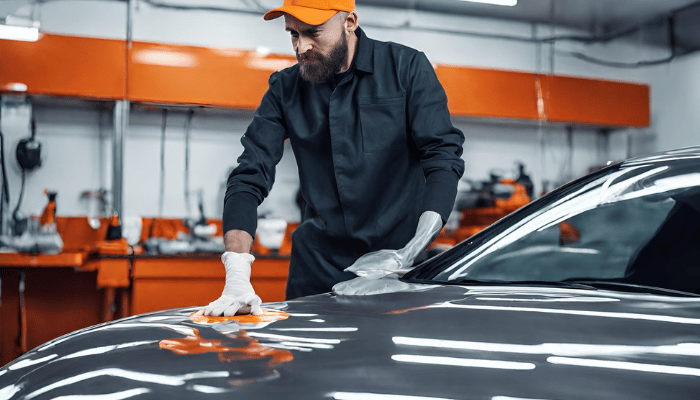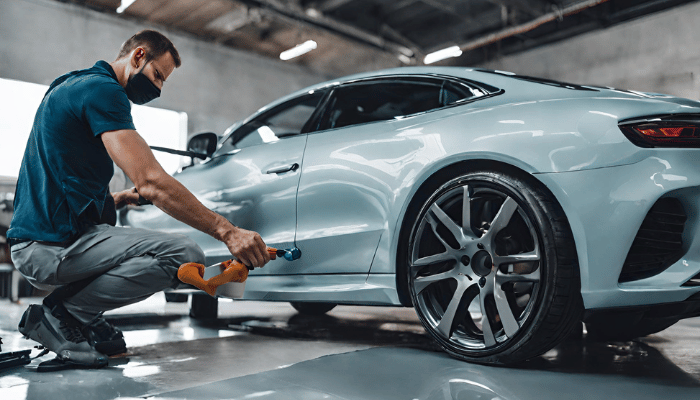How Long Does Ceramic Coating Take to Cure?
Car fans seeking to guard their car paint can opt for ceramic coat. However, one of the questions that has always arisen is, “For how long do we allow ceramic coating to cure?” This blog will give detailed information about the process of curing ceramic coatings.
What is Ceramic Coating?
There is a specific type of paint for cars, called car paint protection, known as ceramic coating. This is a liquid polymer coated on a vehicle’s exterior surface on a manual basis. It is applied and creates chemical bonding with the factory paint on the vehicle surface, forming a protective barrier. After curing, this coating protects against any form of dirt, scratch, chemical etching, or even exposure to UV light on the car’s paintwork. Car enthusiasts like it because it offers excellent protection and makes the car look shiny. Nevertheless, although ceramic coating brings numerous advantages, a car cannot be considered protected, and routine care is required anyhow.

How Long Does Ceramic Coating Take to Cure?
The ceramic coating curing process defines the degree of effectiveness and durability of the coatings as a kind of protection. Here’s a more detailed explanation:
As soon as you start applying a ceramic coating onto your car, it starts drying up. It is only the first stage of that process at the moment. In less than a day or a few moments, the coating may appear dry to the touch for a particular product type under special weather conditions. This does not however imply that the coating has completely cured.
Curing is usually a longer chemical process that can take between 24 and 48 hours. The liquid coating undergoes a chemical reaction and bonds with the paint surface of the vehicle during this time. This bonding, however, is what makes the ceramic coating protective of the surface of the vehicle from scratches, chemical etching, UV damage, and dirt.
It is however imperative to note that the time a ceramic coating cures may differ depending on various reasons. Among these are the particular brand and composition of the coating, as well as climate factors such as temperature and humidity. For instance, the cured concrete will be quicker in a hot and dry environment than it would in a cold and wet environment. However, it might take a longer time in cold or humid surroundings.
The vehicle must be protected from anything that may compromise the curing process, during the period of curing. Water, dust, debris, direct sunlight, and chemicals are included in this. Any one of these components can influence the cure quality, causing streaks, water spots, or an unsightly finish. Thus, it is advised that the car is placed in a controlled and covered environment during the curing process.
The Curing Process
Ceramic coating curing is a chemical process that makes the coating adhere to the car’s paint. Here’s a step-by-step breakdown of the process:
- Application: The car’s surface is covered with a ceramic coating. This is normally done manually using a microfiber applicator. The coating is uniformly distributed on the surface.
- Initial Drying: The coating then starts to dry up after application. This usually happens fast; the coating may feel dry to the touch within minutes to hours. This does not imply that the coating has fully cured.
- Curing: The curing process is a chemical reaction that involves a longer duration, i.e. 24 – 48 hours. This is the time when the coating hardens and bonds with the paint on a molecular level. It is this bonding that allows the ceramic coating to have the protection ability it possesses.
- Full Cure: At the end of curing time, the material has matured to the extent that it has become hardened as well as adhered firmly to the painted surface. There are now abrasion-resistant and UV/chemical-etched protective layers covering the vehicle.
During the curing of bituminous products, it should be avoided such as water, dust, direct sun, or chemicals that can interfere with the curing process. Streaking or uneven finish may result from these factors which affect how the cure takes place. Therefore, one should be able to regulate the surroundings where the vehicle is hardened.
Precautions During the Curing Process
During the curing process of ceramic coating, several precautions should be taken to ensure the best results:
- Avoid Water: Water may interfere with the curing process. Contact before full curing may cause water streaking or spotting. Therefore, one should refrain from washing the car or allowing it to get wet while it is drying.
- Avoid Dust and Debris: Similarly, dust or debris can also affect curing in the same way. If this dust is not fully cured before the coatings are applied they can penetrate through into the coatings and cause staining on the coatings surface which will in turn affect the appearance and performance of the coating.
- Avoid Direct Sunlight: Direct sunlight causes the coating to dry unevenly giving the outcome streaks and spots. Hence, it is advisable to park the vehicle in a covered, shaded place during the curing process.
- Avoid Chemicals: In some car cleaning products, chemicals, that may interfere with the curing process, may be present. The coat should be allowed to cure before any chemical is used on the car.
Observing these precautions will allow the ceramic coating to cure properly and provide maximum protection for the vehicle’s paintwork. The curing process is a critical part of the ceramic coating application process, and spending some time to get it right will improve the durability and performance of the coating.

Conclusion
Understanding how long the ceramic coating cures and what precaution needs to be considered during the curing process can be a guarantee of durability and efficiency. It is important to note that, patience is very crucial when dealing with ceramic coating. The proper time is given to the coating and this leads to a beautiful vehicle that would serve the owner for many years.
However, this is a general rule and, for example, the curing precautions and time can differ depending on the brand and the type of ceramic coating used. For better results always refer to the instructions from the manufacturers.
Remember, the time it takes to cure is an investment in the longevity and beauty of your vehicle. So, give your ceramic coating the time it needs to fully cure, and you’ll be rewarded with a stunning, protected vehicle.
Frequently Asked Questions
1. What is ceramic coating?
This is a liquid polymer that is manually applied to a vehicle’s exterior and dries out to form a ceramic coating. It bonds chemically with the manufacturer’s paint on the vehicle, forming an outer covering. The car paint can be protected from dirt, scratches, chemical etching, and UV damage by this coating which is durable after curing.
2. What is the duration of curing of ceramic coating?
The coating needs to cure on average for the period ranging from 24-48 hours. The specific time may depend upon several factors such as the type of brand used in the coating and the prevailing environmental circumstances e.g. temperature and humidity.
3. Immediately after applying ceramic coating, is it okay for me to drive my car?
It is advisable to wait before driving your car after applying the ceramic coating. Exposure to dust, rain, or chemicals, before the coating has completely cured may interfere with the curing process and affect the quality of the cure.
4. Will I be able to wash my car during the process of curing it?
No, do not wash your car when the process of curing is going on. Water may disrupt the curing process and leave streaks or water spots on the coatings.
5. What happens when ceramic coating gets wet before it cures?
Ceramic coating can result in streaks or water spots if it gets wet before it has fully cured. These are hard to remove and can be ugly and ruin the coating.
6. Will I be able to ceramic coat myself?
Yes, you have to ceramic coat yourself. However, you should follow the manufacturer’s instructions closely for the optimum results. This involves adequately treating the car’s surface, uniformly applying the coating, and ensuring that it completely cures.
7. How long does ceramic coating last?
The longevity of ceramic coating can vary based on several factors, including the quality of the product, the preparation and application process, and how well the coated vehicle is maintained. However, with proper application and care, high-quality ceramic coatings can last for several years.
